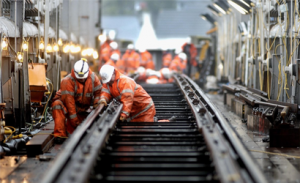New independent report: Network Rail guilty of ‘restrictive and inflexible’ working practices

Network Rail has published an independent study by specialist infrastructure consultancy, Nichols, looking at how maintenance of infrastructure and key assets is carried out in other comparable industries in the UK and across Europe.
The study found that Network Rail lagged behind other industries - such as water, aviation, energy and roads - especially in the way it deploys its people. Specifically, the report highlighted that improvements could be made, and major efficiencies unlocked, by:
- Introducing individual rostering to deploy staff more effectively
- Upskilling specialist and multi-skilled teams with broader knowledge to enable first-response staff to fix most faults and get trains moving faster
- Increasing and accelerating the use of technology to keep employees safer
Andrew Haines, Network Rail chief executive said: “Britain deserves a railway maintenance regime that is modern and fit for the 21st century. Obstructing vital changes that make the railway and its workers safer, and that improve the reliability of services we provide, is in no one’s interest. With common sense and compromise, our proposals can deliver millions of pounds in savings that we can then translate into a better pay offer for all our people. It’s a win-win.”
The Nichols study suggests that productivity and efficiency gains can be realised through ensuring maintenance is done at the right time, by the right number of staff with the right skills. This means:
Individual rostering
Due to existing contractual terms, team managers are required to agree rosters up to 52 weeks in advance, and to roster teams together. In an environment where workload is variable and unpredictable, it can be challenging to flex rosters, particularly if more than one team is needed for the work.
ADVERTISEMENT
Network Rail’s current rostering practice was found to be less flexible and more restrictive than most comparative organisations, who typically roster staff individually, have a shorter roster cycle managed centrally, and did not report issues with deploying staff when required.
Network Rail wants to have more flexibility to independently roster individual staff based on the size, nature, location and timing of the work. This could be further enabled by a centralised resourcing function that exists to oversee overall business needs.
Network Rail is confident that the changes required can be made without the need for compulsory redundancies. Around 1,800 jobs will go in total, but with voluntary severance desired by hundreds of employees, and with natural wastage, redeployment and retraining, the organisation is confident there will be a job for all who want one.
Introducing multi-skilled, multi-functional teams
Currently, maintenance responsibility is divided into Network Rail’s 14 routes and then further into Maintenance Delivery Units. These are organised into three separate discipline-based teams: Track, Signalling and Telecoms, and Electrification and Plant (E&P). A standard team is made up of three to four people: a Team leader, Technician(s) and Operative(s) trained in skills only required within that discipline.
When a team is assigned to a job, the whole team will travel to site regardless of the size of the task. And where a job requires more than one discipline (for example, signalling and track), more than one team will be in attendance but often working sequentially. This results in large periods of wasted time where team members wait for tasks to be completed by other disciplines before they can start work.
There is a more efficient and productive way of working. By creating joint multidisciplinary teams, as opposed to individual disciplines, the number of employees required to maintain the network, and associated costs, are reduced.
Introducing such teams would also help ensure work can be carried out across geographic boundaries. Current working practices in the rail industry dictate that teams in one route won’t assist another in a neighbouring area even if it has capacity to do so.
Increasing adoption of technology
Britain’s railway is the safest major railway in Europe, and there have been huge strides in improving safety over the last 20 years. This has often been in the face of initial reluctance from trades unions, who still tend to frustrate efforts to adopt technology on the railway.
While the study asserts that Network Rail has made significant advances in its use of technology, the organisation believes that further improvements are achievable as the deployment of such technology has been slow. The table below illustrates how almost a dozen key technological improvements have been blocked by the RMT for over two years.
Analysis by Network Rail suggests that existing maintenance scheduled tasks could be reduced by up to 50% through better use of technology and data, reducing the number of manual inspections carried out by maintenance teams and improving safety. Indeed, a recent report by McKinsey on maintenance for rolling stock suggested remotely enabled condition-based maintenance can reduce manual inspections by at least 60% and reduce costs by over 10%. It’s the railway equivalent of replacing a quarterly manual utilities meter reading with a smart meter.
To take full advantage of technology deployment, Network Rail must have the flexible and responsive working practices that other sectors are using.

